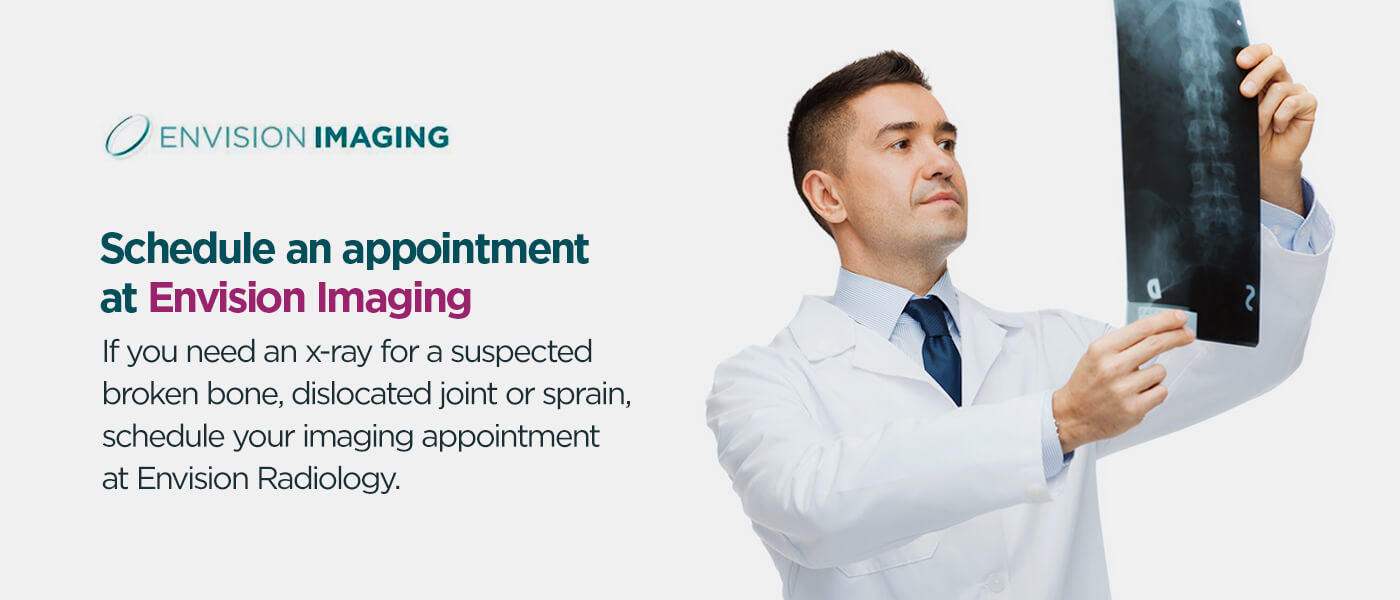How to tell if you need an x-ray
When something hurts or otherwise doesn’t feel quite right, medical professionals have several options for investigating it. Taking internal images allows health providers to diagnose an injury or condition and create a treatment plan. One imaging option that has been around for over a century is the x-ray. X-ray imaging captures pictures inside the body using beams of electromagnetic energy.
Sometimes, your health care provider might schedule an x-ray as a preventive measure. If you experience an injury or acute illness, your doctor might suggest an x-ray to better understand what’s happening.
Jump to Sections:
- What are x-rays used for?
- When should you get an x-ray?
- Signs you might need an x-ray
- Common acute injuries that might require x-rays
- Sprains
- Dislocations
- Fractures
What are x-rays used for?
The medical profession uses x-rays for various purposes. One common use is as a screening method. For example, mammography can help your treatment team discover lumps or tumors in your breasts. A mammogram can detect tumors that are too small to feel during a self-breast exam and can be a reliable way to catch and diagnose breast cancer in the earliest stages, when it responds best to treatment.
Dentists also use x-rays to capture images of the teeth and gums. A dental x-ray can show signs of cavities, problems with the roots of teeth or issues with the jaw and bone.
If a patient is having trouble breathing or is experiencing chest pain, a doctor might schedule a chest x-ray to see what is going on in the heart or lungs. A chest x-ray can show an enlarged heart or fluid buildup in the heart or lungs. The imaging can also reveal signs of lung cancer, pneumonia or tuberculosis.
A medical provider will most likely order an x-ray if a patient has a suspected bone fracture. Fracture x-rays are among the most common uses of x-ray imaging.
The images captured by an x-ray are black and white. The x-ray’s appearance depends on how well the magnetic waves travel through the organs and material inside the body. For example, bones have lots of calcium, which absorbs x-ray energy very well. Because of the absorption, bones typically show up as white on the imaging.
Air doesn’t absorb energy well, so areas with a lot of air, such as the lungs, usually look black on x-ray images. If there’s a break in a bone, it will look black, too. Meanwhile, growths or masses in the lungs often appear white or gray.
When should you get an x-ray?
If you’ve experienced an injury or aren’t feeling well in general, you might be wondering, “Do I need an x-ray?” Usually, your health care provider will recommend an x-ray if they can’t diagnose the issue by examining you via sight and touch. An x-ray can provide a clearer idea of what’s going on inside your body, allowing your medical provider to give you the best treatment available.
Signs you might need an x-ray
You might need an x-ray if you have an injury or illness and are experiencing any of the following symptoms.
- Trouble walking or moving a limb: If you have hurt your ankle, leg or foot and are having difficulty taking even a few steps, an x-ray will tell your provider whether you have a fractured bone. While a sprain will not show on an x-ray, the imaging can help rule out a broken ankle or foot bone.
- Persistent swelling: If you have swelling that doesn’t go down after several days, an x-ray can reveal if there is something else going on, such as a bone fracture or fluid around a joint. The imaging might also show some signs of changes to the soft tissue inside your body that might contribute to internal inflammation.
- Joint pain or stiffness: X-rays can diagnose arthritis and can help your doctor monitor the condition of your joints. The images can also reveal fluid buildup due to a joint injury.
- Trouble breathing: Chest x-rays help providers diagnose chronic lung issues such as lung cancer or more acute conditions such as pneumonia. An x-ray also shows changes to the heart that can affect your respiration.
- Digestive troubles: If you are experiencing digestive issues, an x-ray, usually with a barium swallow, can give a doctor an idea of what’s going on. X-rays also show the location of swallowed, non-edible items, such as marbles, dice and keys.
Common acute injuries that might require x-rays
After an injury, an x-ray can give your medical team an idea of the best way to proceed with treatment. Broken bones, sprained joints and dislocated joints are a few of the most common injuries that benefit from x-ray imaging.
Sprains
Do you need an x-ray for a sprained ankle? Not all the time. If the sprain is mild and isn’t affecting your ability to walk or do other activities, you probably don’t need imaging. The sprain isn’t likely to show up on the x-ray, anyway.
In the case of a severe sprain that impacts your ability to walk or move, your doctor might order an x-ray to verify that it is a sprain, and not something else. Sometimes, a fractured foot or ankle bone causes symptoms that are similar to a sprained ankle. The same is true of sprains in other parts of the body, such as the wrist. An x-ray can rule out or confirm if the issue is due to a sprain or a broken bone.
Dislocations
A joint becomes dislocated when something forces it out of position. A fall can cause dislocation, especially if you fall directly on the affected joint. Shoulders, fingers, elbows and hips are a few of the joints that are most likely to become dislocated.
X-rays can show the severity of the dislocation. They can also let you know if something else is going on in the area around the joint, such as a broken bone.
Fractures
In some cases, an x-ray isn’t necessary to diagnose a broken bone. With an open fracture, part of the bone breaks through the skin and the fracture is visible to the naked eye. Other types of fracture are harder to spot. For example, with stable fractures, the bone breaks but seems to have barely moved. A horizontal fracture can also be challenging to detect visually.
An x-ray will pick up a fracture and show it as a black line or lines across the bone. Using an x-ray, your medical provider can diagnose the type of fracture you have and determine the best way to set the bone to allow it to heal.
Schedule an appointment at Envision Imaging
If you need an x-ray for a suspected broken bone, dislocated joint or sprain, schedule your imaging appointment at Envision Imaging. We have locations across Texas, Louisiana, Oklahoma and Colorado. Find a location nearest you to book your imaging appointment today.
Sources:
- https://www.envrad.com/services/mammography/
- https://www.envrad.com/services/x-ray/
- https://www.envrad.com/locations/
- https://www.mayoclinic.org/tests-procedures/x-ray/about/pac-20395303
- https://medlineplus.gov/xrays.html
- https://my.clevelandclinic.org/health/articles/11199-dental-x-rays
- https://www.verywellhealth.com/knee-x-rays-2549626
- https://www.independentimaging.com/what-irregularities-can-an-x-ray-detect/
- https://www.webmd.com/a-to-z-guides/what-is-x-ray
- https://orthoinfo.aaos.org/en/diseases–conditions/sprained-ankle/
- https://www.mayoclinic.org/diseases-conditions/dislocation/diagnosis-treatment/drc-20354119
- https://orthoinfo.aaos.org/en/diseases–conditions/fractures-broken-bones/
- https://convenientmd.com/acute-injuries-do-i-need-an-x-ray/
- https://www.bettermedcare.com/how-to-tell-if-you-need-an-x-ray.html
- https://www.hopkinsmedicine.org/health/treatment-tests-and-therapies/xrays
- https://www.fda.gov/radiation-emitting-products/medical-imaging/medical-x-ray-imaging


![Signs you might need an x-ray [list]](https://www.envrad.com/content/uploads/2021/05/02-Signs-you-might-need-an-X-Ray-rev1.jpg)

